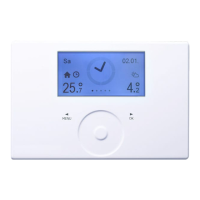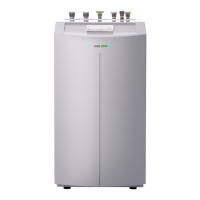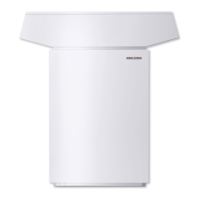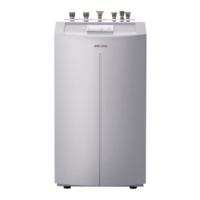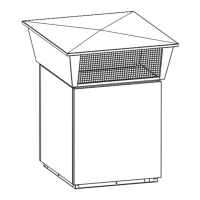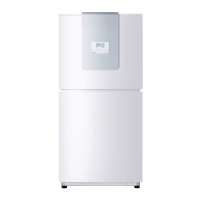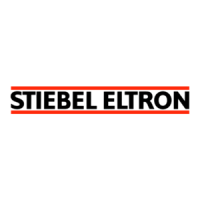
Do you have a question about the STIEBEL ELTRON WPM 3 and is the answer not in the manual?
| Brand | STIEBEL ELTRON |
|---|---|
| Model | WPM 3 |
| Category | Heat Pump |
| Language | English |
Provides an overview of the WPM 3 heat pump manager and its intended use.
Details on safety instructions, including symbols and keywords for risk identification.
Explains symbols used for general information and appliance disposal.
Specifies that measurements are given in millimeters unless otherwise stated.
Covers intended use, safety instructions, and test symbols for safe operation.
Defines the appliance's purpose for domestic use and cautions against other applications.
Provides crucial safety guidelines for installation, operation, and user maintenance.
Refers to the appliance type plate for test symbols.
Describes the WPM 3 heat pump manager and its role in controlling heat pumps.
Lists and categorizes different heat pump types compatible with the WPM 3 manager.
Details accessories like FE7 and FEK remote controls, ISG, and mixer modules.
Explains the functions and controls of the FE7 remote control unit.
Describes the functions and controls of the FEK remote control unit.
Details the ISG's function as an Ethernet gateway for remote access and monitoring.
Describes the MSMW as an extension module for additional functions.
Explains the MSMS 3 as a control panel module for extended functions.
Outlines how to operate the heat pump manager, focusing on controls and display.
Details the programming unit's controls: MENU, OK, and scroll wheel.
Explains the start screen layout and its four sections displaying system status.
Describes the touch-sensitive scroll wheel and its operation.
Explains how to navigate menus and adjust values using the scroll wheel.
Details the functions of the MENU and OK keys for navigation and confirmation.
Notes that some menu items require contractor access via code.
Guides on how to change parameters using the scroll wheel and OK key.
Explains how to select and change operating modes like Comfort, ECO, DHW, Standby, and Emergency.
Describes Standby mode for periods of absence, activating frost protection.
Details programmed operation for heating and DHW, including remote control use.
Explains Comfort mode for maintaining constant comfort temperatures.
Describes ECO mode for lower energy consumption.
Outlines DHW heating schedules and frost protection.
Explains emergency operation for heat pumps with integral or external second heat sources.
Explains the various symbols displayed to indicate the heat pump's operating status.
Provides an overview of the WPM 3's menu hierarchy for accessing parameters.
Allows comparison of set and actual values for temperatures, flow rates, and pressures.
Displays system information including room, heating, DHW, cooling, solar, and external heat source data.
Shows power consumption and process data for heat pumps 1-6, including runtime and start counts.
Enables troubleshooting and analysis of process data and BUS subscribers.
Lists the status of various system components like pumps, valves, and modes.
Displays the operational status of individual heat pumps 1-6.
Provides analysis data for heat pumps 1-6.
Contains system-wide information and bus subscriber details.
Shows internal calculation parameters and live stages.
Lists registered faults.
Allows testing of system relay outputs.
Enables testing of heat pump relay outputs.
Lists recent faults with timestamps and fault codes.
Displays the current fault message on the appliance.
Allows individual switching of relay outputs for testing.
Used to adjust heating, DHW, holiday, and party modes, and start heat-up programs.
Sets heating times for heating circuits 1 and 2.
Configures DHW heating times.
Allows extending comfort mode for heating by a few hours.
Sets ECO mode and frost protection for DHW during holidays.
Used for drying screed with defined temperature profiles.
Details how to set heating time programs for comfort and ECO modes.
Explains how to set DHW heating times for comfort and ECO modes.
Allows extending comfort mode for heating by a few hours.
Configures holiday mode for ECO operation and DHW frost protection.
Details the heat-up program for underfloor heating systems.
Explains the heat-up program parameters for drying screed.
Reduces fan speed for quieter operation of specific heat pump types.
Switches off the heat pump, using secondary heat for heating.
Allows setting system-specific parameters for heating, cooling, DHW, and general settings.
Covers general settings like time, date, summer time, contrast, and brightness.
Contains settings for heating circuits 1 and 2, standard settings, remote control, and pump cycles.
Settings for comfort, ECO temps, minimum temp, room influence, and heating curves.
Settings for comfort, ECO temps, minimum temp, mixer dynamics, and heating curves.
Defines buffer operation, summer mode, and flow/return temperature control.
Settings related to DHW temperatures, modes, hysteresis, stages, and learning functions.
Sets comfort and ECO temperatures for DHW.
Configures DHW priority, parallel, or partial priority operation.
Settings for cooling modes, stages, limits, capacity, and area/fan cooling.
Selects between passive and active cooling modes.
Defines cooling stages, limits, and capacity.
Adjusts mixer characteristics for optimal control deviation and runtime.
Adjusts room temperature sensor influence on control.
Sets the heating curve slope for heating circuits.
Displays heating curves relating to room temperature settings.
Explains room temperature influence on return/flow temperature control.
Details cascade control using weather and room temperature for return/flow settings.
Describes setting heating curves for circuits 1 and 2.
Shows heating curves for comfort and ECO modes based on outside temperature.
Sets buffer cylinder operation to ON or OFF.
Defines when the heating system switches to summer mode.
Adjusts outside temperature settings for building heat buffer.
Selects building type to determine average outside temperature.
Sets flow or return temperature control for the heating system.
Sets maximum return temperature to prevent high pressure limiter response.
Controls heating circuit pump cycling for efficiency.
Enables or disables pump cycling for heating circuit 1.
Prevents pumps from seizing up during inactivity.
Behavior of pumps when connected to remote controls.
Protects the heating system from frost.
Selects heating circuit for FE7 remote control.
Chooses which heating circuit the FE7 remote control acts on.
Corrects measured room temperature.
Limits the maximum heat pump flow temperature for heating.
Ignores time switch program for regulated fixed values.
Dynamically optimizes heating curve for room demand.
Configures external heat sources like immersion heaters and boilers.
Describes conditions for starting and operating immersion heaters.
Details boiler integration and operation for heating circuit 2.
Refers to settings for threaded immersion heaters and boilers.
Refers to boiler temperature settings.
Sets operation of HS 2 during power-off periods.
Switches off heat pump below a set outside temperature limit.
Determines dual mode temperature for heating.
Defines I component for HS 2.
Sets application limits and dual mode temps for electric reheating.
Configures the number of DHC heating stages.
Sets start delay for DHC heating stages.
Sets comfort and ECO temperatures for DHW.
Configures external heat sources for DHW heating.
HS 2 backs up heat pump below dual mode point.
HS 2 provides DHW heating below dual mode point.
HS 2 provides DHW heating independently.
Sets dual mode temperature for DHW heating.
Switches off heat pump below DHW application limit.
Determines switching hysteresis for DHW heating.
Preselects the number of heat pump stages for DHW.
Enables automatic DHW mode based on outside temperature.
Sets outside temperature for enabling additional DHW stages.
System automatically adjusts DHW temperature.
Sets heat pump heating outputs in DHW mode.
Optimizes heat pump efficiency in DHW mode.
Sets higher output for short heat-up times in DHW mode.
Limits the maximum heat pump flow temperature for heating.
Heats DHW cylinder daily to 60 °C if enabled.
Sets dual mode temps and application limits for electric reheating.
Sets cooling capacity for specific heat pump types.
Configures active cooling settings for area and fan cooling.
Configures passive cooling settings for area and fan cooling.
Details cooling mode usage with the FE7 remote control.
Explains cooling mode usage with the FEK remote control.
Warns about potential damage from incorrect wiring.
Configuration steps for WPF cooling settings.
Configuration steps for WPL cooling settings.
Lists standard control unit settings for cooling.
Adjusts dynamics for passive and active cooling.
Explains dynamics for passive cooling in cascade control.
Details dynamics for active cooling.
Describes how passive cooling is initiated and controlled.
Explains the stages and dynamics of active cooling for WPF.
Configures solar mode parameters like cylinder temperature and differential.
Explains how fault messages are displayed on the appliance.
Provides instructions for cleaning and maintenance of the appliance.
Emphasizes that only qualified contractors should perform installation, commissioning, maintenance, and repair.
Stresses the use of original accessories and spare parts for reliability.
Advises observing all applicable national and regional regulations.
Lists the components included in the WPMW 3 and WPMS 3 packages.
Details the components for the wall mounting version.
Lists the components for the control panel mounting version.
Provides instructions for installing the heat pump manager.
Specific instructions for wall mounting the WPMW 3 unit.
Guidance on mounting the WPMS 3 control panel.
Instructions for installing the programming unit to an internal wall.
Describes how to install the unit with or without a flush box.
Covers general electrical connection requirements and safety.
Provides crucial safety warnings for electrical connections and power supply.
Details connections for circulation pumps and mixers, including approvals.
Explains cable entry suitability and wiring practices for WPMW 3.
Specifies the type of cable and routing for BUS connections.
Details terminal assignments for power supply voltage.
Lists terminal assignments for low voltage connections, including sensors.
Covers wiring practices for BUS cables and terminals for WPMS 3.
Illustrates BUS cable connections for WPMS 3.
Shows terminal assignments for the WPMS 3 connection array.
Guides on installing contact sensors (AVF 6) for various heat pump types.
Details connection requirements for AVF 6 sensor with different heat pump types.
Instructions for fitting the sensor in the heating circuit return.
Instructions for fitting the sensor as a return temperature sensor.
Describes the electrical connection at the user interface.
Explains the use of immersion sensors for buffer cylinders.
Provides guidelines for positioning and insulating the outside temperature sensor.
Lists resistance values for PT 1000 and KTY sensors at different temperatures.
Details how to connect the FE7 remote control for temperature adjustment.
Explains the connection of the FEK remote control for temperature and mode changes.
Describes connecting the ISG for network access and remote operation.
Outlines the process for commissioning the heat pump manager and system.
Steps for connecting the BUS cable and assigning appliance addresses.
Explains connecting heat pumps via BUS cables.
Specifies the order for installing heat pumps and connecting sensors.
Procedures for reinitialising the IWS if commissioning fails.
Describes how to reset the heat pump after a specific fault.
Explains the commissioning menu structure and parameter protection.
Details how to enter the four-digit code for parameter changes.
Allows selection of the menu language.
Configures frost protection for ground source heat pumps.
Sets the minimum source temperature to prevent compressor shutdown.
Settings for heating controller dynamics, hysteresis, spread control, and pump rates.
Adjusts switching interval between compressor and booster heater.
Sets the start-up hysteresis for the heat pump.
Controls circulation pump flow rate automatically.
Sets temperature differential between flow and return sensors.
Sets the maximum flow rate for the pump.
Sets minimum pump rate for the internal circulation pump when idle.
Sets the flow rate via the heating circuit pump output.
Settings for DHW circuit pump rating and compressor parameters.
Sets maximum flow rate for the DHW pump.
Configures minimum defrost time, start defrost, and idle time.
Sets pre-selectable time for defrost process.
Initiates manual defrosting.
Details defrost mode for specific heat pump types.
Describes defrost mode operation for HP types 3/3*.
Explains defrost mode for HP types 4/4*.
Details defrost mode for HP type 5/5*.
Sets the maximum duration for the defrost process.
Sets the idle time to protect the compressor after shutdown.
Limits maximum power consumed by the heat pump.
Sets countdown for compressor runtime.
Sets heat demand for the house.
Selects the outside temperature for heat demand calculation.
Selects the calculated heat demand.
Determines heating output in fixed value and heat-up programs.
Activates ribbon heater at low outside temperatures.
Selects the outside temperature.
Enables or disables single-phase operation.
Tests heat pump function by triggering a quick start.
Configures silent mode for reduced heat pump noise.
Activates silent mode for reduced sound level.
Reduces fan speed for silent programs.
Reduces compressor output for silent programs.
Reduces fan speed for silent programs.
Switches off heat pump for silent program 2.
Describes automatic switchover to emergency operation on fatal error.
Resets the heat pump after a fault occurs.
Deletes the entire fault list.
Resets the heat pump manager to factory settings.
Allows correction of displayed sensor temperatures.
Corrects displayed flow temperature for WP.
Corrects displayed flow temperature for NHZ.
Corrects displayed return temperature for WP.
Lists adjustable parameters for the programming unit.
Parameter for party program hours.
Parameters for the heat-up program.
General settings for contrast, brightness, and touch sensitivity.
Settings for comfort, ECO temps, minimum temp, room influence, and heating curves.
Settings for comfort, ECO temps, minimum temp, mixer dynamics, and heating curves.
Configures buffer operation, summer mode, and flow/return temperature control.
Sets heating circuit preselection and room influence for FE7.
Configures pump cycles for heating.
Configures external heat sources like immersion heaters and boilers.
Sets application limits and dual mode temps for electric reheating.
Sets comfort and ECO temperatures for DHW.
Configures DHW priority, parallel, or partial priority operation.
Sets dual mode temps and application limits for electric reheating for DHW.
Configures external heat sources for DHW heating.
Settings for cooling modes, stages, limits, capacity, and area/fan cooling.
Selects between passive and active cooling modes.
Defines cooling stages, limits, and capacity.
Configures active cooling parameters for area cooling.
Configures active cooling parameters for fan cooling.
Configures passive cooling parameters for area cooling.
Configures passive cooling parameters for fan cooling.
Configures solar mode parameters like cylinder temperature and differential.
Covers commissioning steps like entering codes, setting language, and source parameters.
Configures source parameters for heat pumps.
Settings for heating controller dynamics, hysteresis, spread control.
Settings for DHW circuit pump rating.
Configures compressor parameters like defrost time, idle time, and runtime.
Configures silent mode settings.
Enables or disables emergency operation.
Resets the heat pump after a fault occurs.
Deletes the entire fault list.
Resets the heat pump manager to factory settings.
Allows correction of displayed sensor temperatures.
Provides pre-programmed standard settings and tables for recording custom settings.
Lists factory default settings for heating and DHW programs and temperatures.
Default switching times for heating circuits.
Default comfort and ECO temperatures.
Default DHW program switching times.
Default DHW comfort and ECO temperatures.
Default values for heating curve slopes.
Tables for users to record their custom settings.
Table to record custom heating program settings for circuit 1.
Table to record custom heating program settings for circuit 2.
Table to record custom DHW program settings.
Instructions for explaining the appliance's function to users.
Guides on identifying and resolving faults in the system and heat pump.
Explains how faults are indicated on the display and the general fault handling process.
Lists common faults for HP types 1, 1*, 2, and 2* with reasons and possible remedies.
Details faults specific to HP types 1 and 1*.
Details faults specific to HP types 2 and 2*.
Details faults specific to HP types 3 and 3* with reasons and remedies.
Details faults specific to HP types 4 and 4*.
Continues listing faults for HP types 4 and 4*, including inverter faults.
Lists faults related to the multifunction assembly MFG.
Faults related to communication between IWS and inverter for fan section.
Faults related to high relevance communication between IWS and inverter.
Continues listing faults for HP types 4 and 4*, focusing on sensor and pressure issues.
Details faults specific to HP types 5 and 5* with reasons and remedies.
Fault related to superheating below minimum value.
Fault related to multiple DEFROST occurrences.
Fault for minimum flow temperature not reached during cooling.
Fault for condenser outlet sensor value outside permissible range.
Major inverter fault for excess current.
Major inverter fault for PFC excess current.
Major inverter fault for AC input excess voltage.
Lists faults related to MFG communication and components.
Explains the "SENSOR BREAK" fault message and lists common sensor errors.
Addresses common faults like heat pump not running or display issues.
Discusses reasons why the heat pump might not run.
Provides steps to resolve WPM display unresponsiveness.
Provides product specifications and data tables.
Details energy consumption compliance with EU regulations.
Presents electrical data, power supply, IP rating, and dimensions.
Outlines guarantee conditions for appliances acquired inside and outside Germany.
Advises on proper disposal of materials according to regulations.
